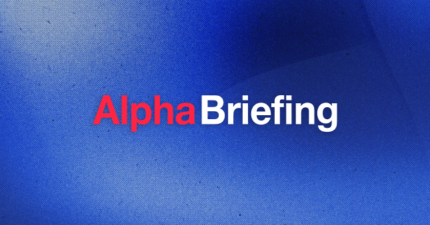Money20/20 USA – Event Wrap Up

Money20/20 USA AlphaPoint Global Highlights
AlphaPoint sponsored Money20/20 USA, a gathering of industry pioneers in finance and technology shaping the future of money.
The Money20/20 USA conference took place in Las Vegas, Nevada, hosted at the epicenter of the iconic Las Vegas Strip. This year’s #1 banking conference included 13,000 attendees, 3,000 leading companies, 350+ industry-leading speakers, and 60+ hours of educational content.
AlphaPoint united with industry trailblazers, as our expo booth became the nexus for innovative discussions and networking opportunities with numerous visionary leaders. Our team showcased how AlphaPoint’s cutting-edge technology is revolutionizing the financial industry. We demonstrated our commitment to providing blockchain and digital asset infrastructure solutions that empower our clients to drive innovation, efficiency, and growth in their businesses.
Below are key takeaways from several speaking sessions covering topics ranging from core banking modernization to the impact of emerging technologies like AI and quantum computing on digital payments.
Money20/20 USA: Top 4 Key Takeaways
- Core Banking Modernization Trends and Best Practices
Why it matters: Digital services improve customer experience by providing faster and more convenient banking services. The use of blockchain technology, security measures, and compliance ensures a secure and efficient environment for managing digital assets. Additionally, real-time processing, data analytics, and AI provide valuable insights and personalized recommendations, while interoperability and an API ecosystem foster partnerships and innovation.
The big picture: Improvement of digital services helps save money and makes it easy to switch from old systems. It also ensures customer help, following rules, and verifying identities using blockchain. Ultimately, these advancements align with the evolving landscape of digital assets and the need for customer education.
Scalability: A modernized core infrastructure capable of handling increased transaction volumes. Adaptation to accommodate the growth of digital assets and decentralized finance (DeFi).
Blockchain Integration: Integration of blockchain technology for secure and efficient digital asset management. Support for cryptocurrencies and other blockchain-based assets.
Security and Compliance: Enhanced cybersecurity measures to protect digital assets and customer data. Compliance with evolving regulatory requirements in the digital finance space.
Real-time Processing: Near real-time transaction processing for digital asset trading and settlements. Reduced latency for instant fund transfers and payments.
Data Analytics and AI: Utilization of data analytics and artificial intelligence to gain insights into customer behavior and digital asset trends. You can also get personalized product recommendations and risk assessments.
- The Impact of AI, Quantum Computing, and Cryptocurrencies on Payments
Why it matters: Quantum computing worries about security, but studying quantum-resistant cryptography and blockchain security upgrades are crucial for protecting digital assets.
The big picture: AI and blockchain technologies can streamline payment processes, reduce fees, enhance security, and introduce innovative payment methods, expanding global accessibility to digital asset payments.
Market Analysis: AI is being used to analyze market data, predict price trends, and make informed trading decisions in the cryptocurrency market.
Risk Management: AI algorithms can assess and manage risks associated with digital asset investments, helping traders and investors make better decisions.
Cryptography Vulnerability: Quantum computers have the potential to break widely-used cryptographic algorithms, posing a threat to the security of digital asset transactions.
Quantum-Resistant Cryptography: Research is ongoing to develop quantum-resistant cryptographic methods to protect digital assets from quantum attacks.
Global Accessibility: Digital assets can provide a more inclusive and accessible means of payment for individuals and businesses worldwide, particularly in areas with limited access to traditional financial systems.
- Payments Ecosystem Transformation in Latin America
Why it matters: The digital payments boom in LATAM is changing financial ecosystems with more use of mobile wallets, contactless payments, and QR codes. The shift away from cash has significant impacts. It makes cross-border payments simpler and alters regulations. It also leads to the creation of digital currencies by central banks.
The big picture: Additionally, it includes more individuals in the financial system and promotes innovation in financial technology. Furthermore, it helps prevent money laundering and protects consumers. Moreover, it involves building payment systems through partnerships and incorporates sustainable finance practices.
These changes aim to solve problems with people not having access to banks and with fraud. They also want to help the economy grow, especially in Mexico and Brazil. Brazil’s Pix system shows how important it is to deal with these issues. Brazil may be next to make Bitcoin Legal tender, but it may be in the next two years or so.
Digital Payments Boom: There is a continued growth of digital payment methods like mobile wallets, contactless payments, and QR codes and an increased adoption due to the COVID-19 pandemic that accelerates the shift from cash to digital payments.
Cross-Border Payments: There are efforts to streamline and simplify cross-border payments, reducing costs and friction for businesses and consumers. You must always keep in mind the regulatory initiatives to promote interoperability and cross-border digital asset usage.
Regulatory Frameworks: There is an evolving regulatory landscape to address the challenges and opportunities presented by digital assets and greater clarity on cryptocurrency regulations to attract investment and foster innovation.
Central Bank Digital Currencies (CBDCs): There is a huge exploration and development of CBDCs by various Latin American countries to enhance payment efficiency, financial inclusion, and monetary policy control. Pilots and trials of CBDCs are used as a means to modernize the payment system.
Financial Inclusion: There are many initiatives to expand access to financial services, targeting the unbanked and underbanked populations. One way to do this is by leveraging digital assets and mobile technology to provide financial services to remote areas.
- Drivers of Digital Wallet Adoption in Key Latin American Markets
Why it matters: Digital wallets are experiencing significant growth in Latin America due to factors such as increased smartphone usage, improved internet connectivity, financial inclusion efforts, and currency instability. They are also facilitating cross-border transactions.
The big picture: In the case of Peru, high mobile phone penetration, government initiatives, and cryptocurrency acceptance are contributing to digital wallet adoption. In Puerto Rico, digital wallet adoption is influenced by the territory’s connection to the US, its emergence as a blockchain and cryptocurrency hub, digital asset regulation efforts, and the convenience for tourists. Peru is looking to work with banks to foster their digital asset growth through Yape, as banks are earning review into the product.
Currency Instability: In some LATAM countries, like Venezuela and Argentina, currency instability has led to a surge in digital wallet usage, with users seeking more stable digital assets as a store of value.
Cross-Border Transactions: Digital wallets are facilitating cross-border transactions, making it easier for immigrants to send remittances back to their home countries, with digital assets often used to reduce fees.
Mobile Phone Penetration: High mobile phone penetration in Peru has contributed to digital wallet adoption, with users increasingly relying on mobile devices for financial transactions. Yape, the mobile payment app of Banco de Crédito del Perú was launched in February 2017. Yape has hit 2 million users, allowing them to get loans through this application. Peru has 13 million users on Yape out of a 30 million population.
Digital Asset Regulation: The local government is working on regulatory frameworks for digital assets and blockchain technology, which can encourage adoption and investment in digital wallets.
Tourism: As a popular tourist destination, Puerto Rico’s digital wallet adoption is also driven by the convenience of accepting digital payments, including cryptocurrencies, to cater to a global audience.
Take a glimpse into AlphaPoint’s most cherished memories from Money20/20 USA 2023:





Promoting Financial Inclusion
Money20/20 USA is an important event for leaders, innovators, and visionaries in finance and fintech. The conference allowed people to connect, share info, and collaborate on finance topics and new trends. Money20/20 is a significant event that influences the future of finance. It provides us with a glimpse of the opportunities and challenges in our industry.
Implementing new forms of payment systems such as digital wallets will make a huge impact on global financial inclusion. They can help people without bank accounts access transactions, savings, credit, and more at a low cost and securely. This is possible through the use of new technology and partnerships, a key takeaway that attendees had the chance to learn about at this year’s conference.
AlphaPoint’s Global Impact
If we missed the opportunity to connect with you at Money20/20 USA, arrange a meeting with our team to explore how our white label software services can complement your digital asset strategy, encompassing our exchange/marketplace platform, liquidity solutions, and more. To find out more, click here. Follow AlphaPoint on Twitter and LinkedIn, and check out all of our upcoming Events. 🚀
Learn more about AlphaPoint’s recent nomination as ‘Best Use of Blockchain Technology’ at US Fintech Awards 2023!


